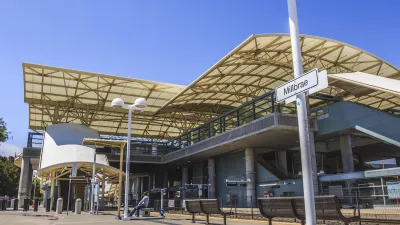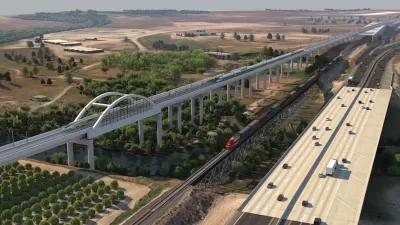James Nash reports that Gov. Jerry Brown is turning to the $6 trillion market in sovereign wealth funds, pensions, and endowments to help fill the $55 billion gap between the project's total cost and what state bonds and federal grants will cover.
Governor Jerry Brown and California state leaders are banking on the increasing interest in public works investments to help fund the most expensive public-works project in U.S. history. "Public works projects have become more attractive to investors seeking stable, if modest, returns in a volatile climate, said Bradley Morrow, a senior consultant for private markets at Towers Watson & Co. (TW), a New York-based professional- services company," writes Nash. “'It’s becoming more accepted as an asset class for institutional investors in North America,' Morrow said, referring to a range of capital projects and not rail specifically."
"The $68.4 billion project, linking San Francisco with Los Angeles, is counting on $10 billion in bonds authorized by voters, $3.3 billion committed by the federal government and as much as $55.1 billion from private sources."
“We have active interest in and outreach to sovereign funds and foreign consortia that are looking at us,” Jeffrey Morales, chief executive of the California High-Speed Rail Authority, said Nov. 29. In addition to sovereign wealth funds, or state-owned investment pools, other potential investors include companies that will build and operate trains and stations, he said."
FULL STORY: Brown Seeks Sovereign Wealth to Back High-Speed Rail Line

Planetizen Federal Action Tracker
A weekly monitor of how Trump’s orders and actions are impacting planners and planning in America.

Restaurant Patios Were a Pandemic Win — Why Were They so Hard to Keep?
Social distancing requirements and changes in travel patterns prompted cities to pilot new uses for street and sidewalk space. Then it got complicated.

Map: Where Senate Republicans Want to Sell Your Public Lands
For public land advocates, the Senate Republicans’ proposal to sell millions of acres of public land in the West is “the biggest fight of their careers.”

Maui's Vacation Rental Debate Turns Ugly
Verbal attacks, misinformation campaigns and fistfights plague a high-stakes debate to convert thousands of vacation rentals into long-term housing.

San Francisco Suspends Traffic Calming Amidst Record Deaths
Citing “a challenging fiscal landscape,” the city will cease the program on the heels of 42 traffic deaths, including 24 pedestrians.

California Homeless Arrests, Citations Spike After Ruling
An investigation reveals that anti-homeless actions increased up to 500% after Grants Pass v. Johnson — even in cities claiming no policy change.
Urban Design for Planners 1: Software Tools
This six-course series explores essential urban design concepts using open source software and equips planners with the tools they need to participate fully in the urban design process.
Planning for Universal Design
Learn the tools for implementing Universal Design in planning regulations.
Heyer Gruel & Associates PA
JM Goldson LLC
Custer County Colorado
City of Camden Redevelopment Agency
City of Astoria
Transportation Research & Education Center (TREC) at Portland State University
Camden Redevelopment Agency
City of Claremont
Municipality of Princeton (NJ)





























